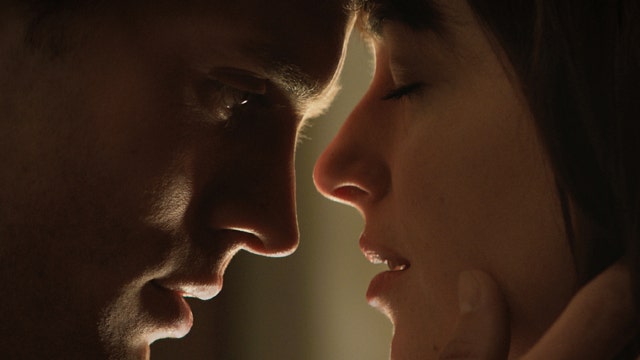'Fifty Shades of Grey' review: Banal and degrading
Ashley Dvorkin and Fox 411 movie reviewer Justin Craig break down the erotic and controversial drama 'Fifty Shades of Grey'
NEW YORK – The difference between “Fifty Shades of Grey’s” enigmatic heartthrob Christian Grey and Ariel Castro, the Cleveland man who imprisoned and sexually abused three women in his home, is a slick gray suit and a few million dollars.
For the uninitiated, “Fifty Shades of Grey” follows Anastasia Steele, a shy college student who falls hard for the dashing CEO Christian Grey when she is tasked to interview him for the school newspaper. Preying on Anastasia’s waifish innocence, Christian invites her into his secret cloistered world, showering her with luxurious gifts, private helicopter rides and life in his Seattle penthouse - all in exchange for the chance to “own” and “dominate” her psychologically and sexually. She inexplicably accepts.
A true 21st Century couple – wink, wink.
The only reason Christian Grey has become a recent icon in popular fiction – albeit a trashy one – is because he is filthy rich. Being a wealthy, debonair playboy has overshadowed being a manipulating sexual predator and has inexplicably made a seemingly quiet, sexually repressed audience swoon. How else could “Fifty Shades” be as successful as it is? If Christian Grey was a balding, pudgy minimum wage-earning convenience store clerk we’d have a very different story on our hands, one more closely resembling Castro in Cleveland. And that Christian Grey would be rightly described by the media as a vile, evil creature.
Though Anastasia does submit to Christian’s predatory actions, they aren’t exactly what she wants. She wants a “normal” relationship – one where she can go to dinner, a movie and then have a pleasant post-coital snuggle. Christian refuses to give her that, denying her everything she wants in a relationship. Furthermore, he is domineering in the most frightening way; Anastasia may have the freedom to leave Christian’s sex chamber and return home at any time, but she is far from a free woman.
One scene has her fleeing to Georgia for a respite with her mother. Angered that she left him in the lurch, Christian flies from Seattle to Georgia to reclaim his ‘property.’ That’s scary stuff, yet Anastasia is just pathetic enough to accept her psychological captivity in the name of romance and ‘pleasure’.
There are also similarities between Anastasia and Christian’s relationship with the horrific one between Michael Fassbender and Lupita Nyong’o in “12 Years a Slave.” Fassbender’s Edwin Epps denies Nyong’o’s Patsey’s freedom, lusts after her and whips her for his own pleasure – and in his warped mind - hopes she’ll in turn want him. Christian does the same to Anastasia, yet somehow in “Fifty Shades” is considered "romance."
Just how sexually explicit is “Fifty Shades of Grey?” It’s mild. Sure there’s plenty of nudity, but more salacious material is shown every day on cable. It’s not even close to late-night Cinemax. You’ll find more disturbing images in “Saw” or “Game of Thrones.”
The mediocre plot, bland characters and tepid tone don’t do any favors. Director Sam Taylor-Johnson treats the movie as serious as a cadaver, which is truly a major disappointment. The screenplay by Kelly Marcel , based on E.L. James’ novel, is empty of message or meaning. Those faults alone make “Fifty Shades” a boring, pointless film.
What this movie lacks is ownership of its trashiness. It desperately needs an injection of some of Paul Verhoeven’s campy, sardonic satire shown in “Showgirls,” “Basic Instinct” or “Robocop.” It needs some commentary on domineering, abusive people, submissive people, our society’s obsession with sex and the taboo of its discussion. But it does none of that.
Dakota Johnson balances Anastasia’s innocence with a slight flair for seduction. While Anastasia is an abomination to female characters in literature and film, Johnson is always watchable. Irish star Jamie Dornan is far too stilted as Christian Grey. Dornan is fantastic on the series “The Fall” starring Gillian Anderson, but here he is an empty suit. Director Johnson should have allowed him to keep his Irish accent which would have made Dornan come across much more natural.
“Fifty Shades” is aces on the technical side. Seamus McGarvey’s cinematography is crisp and pops, especially during the exterior nighttime scenes and in Christian’s swanky pad. Danny Elfman’s score boils beneath the surface, playing second fiddle to a plethora of unnecessary pop songs. But the musical highlight belongs to Beyoncé’s “Crazy In Love,” which makes a dramatic entrance with Anastasia’s first brush with bondage.
In the end, “Fifty Shades” says absolutely nothing. The result is a boring, drawn out call to a sex dungeon that takes an indeterminable amount of time to arrive. The film is often degrading for confusing psychological imprisonment for a relationship. The fine line between abuse and pleasure in “Fifty Shades” is so thin it’s almost non-existent. Here is a Valentine’s Day movie that will certainly make bank at the box office, but you aren’t helping yourself or anyone else by seeing it.
Universal Pictures. MPAA Rating: R. Running time: 1 hour and 50 minutes.





















